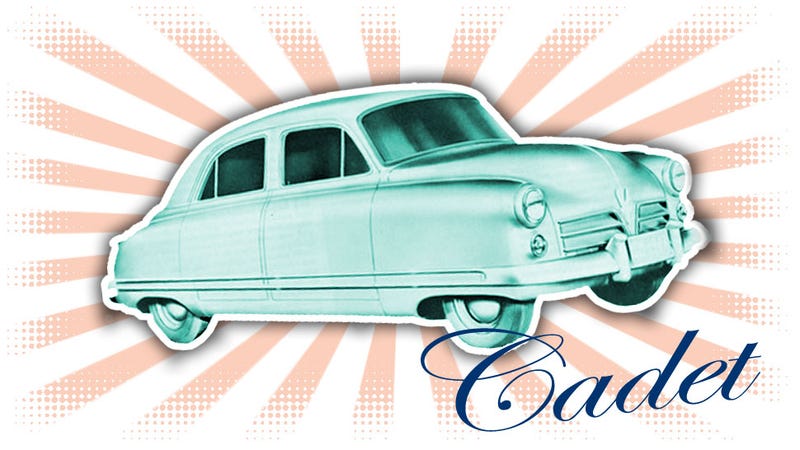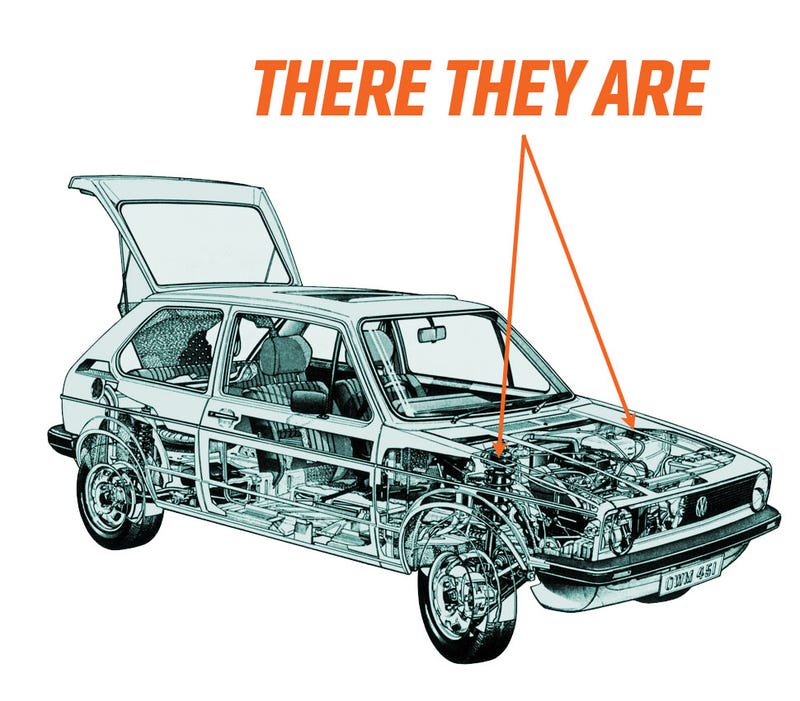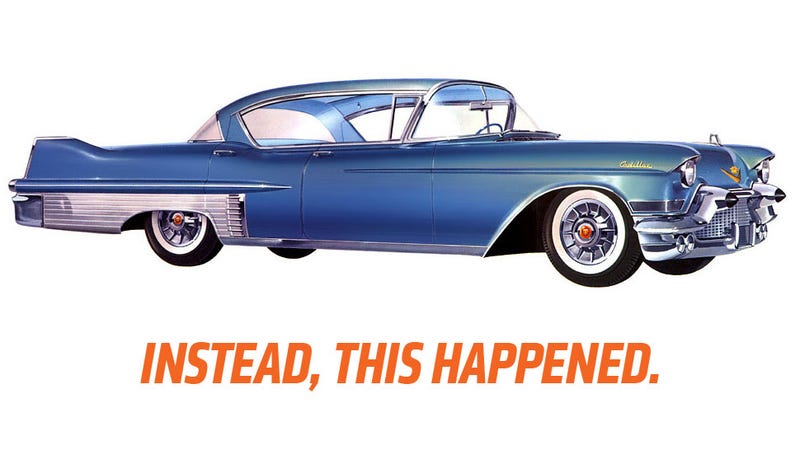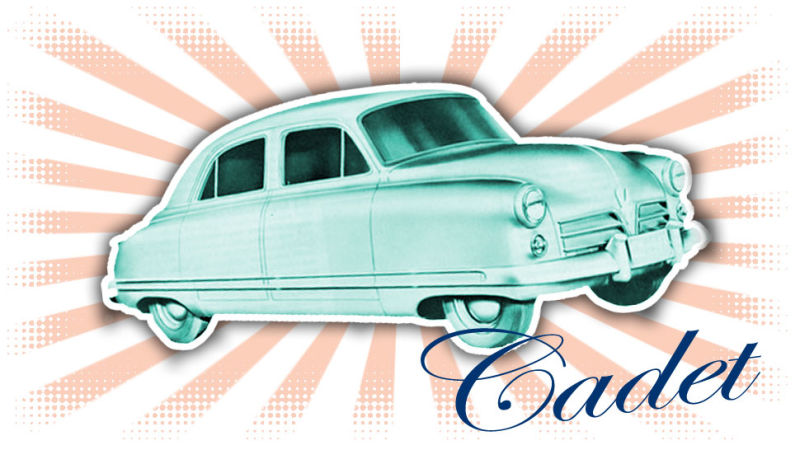
If you were to get up right now, run into a parking lot, and sit on the hood of the first car you find and start bouncing up and down, chances are good that the suspension setup bouncing your ass there is MacPherson strut setup. That setup was born as part of a postwar General Motors program to build a small mass-market car. It could have been great, so naturally, GM killed it.
GM’s killing of that first major small-car project seems to have unleashed a ghost that would haunt their small-car plans for decades to come. It’s only fairly recently that GM seems to have gotten a real grip on building small cars, with their history filled with noble but significant failures like the Corvair, the Vega, the X-body cars, and those Saturns.
The car was to be called the Chevrolet Cadet, and the project was started in 1945 by the one-day famous Earle MacPherson as lead engineer, and M.E. Coyle, a GM General Manager who’d been around long enough to have seen the downturn after the Great War, and wanted GM to be ready this time with a small, very affordable car.
Advertisement

GM Chairman Alfred P. Sloan was far more optimistic about the car-buying habits of post-war Americans (and, it turns out, he was right), but was somehow convinced to let the Chevrolet Light Car Project happen.
They set a goal of $1000 for the car’s price, the sort of round number that started the development of so many cheap peoples’ cars—the original plans for Germany’s KdF-Wagen, the car that would become the Beetle, called for it to sell for under 1000 Reichsmarks, for example.
Sponsored
MacPherson’s Cadet design was remarkably forward-thinking and quite advanced for the era. The Cadet team started with as much of a blank-slate approach as possible, and investigated every possible engineering route to find the one that made the most sense for them.

The layout was a fairly traditional front engine/rear-drive, but that’s not because they didn’t consider others. Rear-engine/rear drive was considered, but handling tests in a weighted test mule made MacPherson leery. Front-wheel drive was considered as well, but MacPherson felt that front-engine/rear drive was still the best way to build a four-passenger car that hit his weight cap of around 2000 pounds.

Even then, it wasn’t that conventional a FR setup, as, in a clever space-saving move, the three-speed gearbox was placed beneath the driver’s seat, which also helped distribute the weight of the drivetrain more evenly. The engine-gearbox-driveshaft-differential train was an interconnected, rigid unit, held together with tubes surrounding the shafts, and was mounted at front and rear.
The car was a unibody, and the whole car wasn’t big—only about 48 inches wide and with a wheelbase of 108 inches. The design was fairly conventional, and had the then-stylish and very Nash-like skirted wheels at every corner. To get this look and maintain a decent turning circle, tiny 12-inch tires were specified.
Advertisement
That’s sort of comical-looking to modern eyes, but a small wheel and tire does give more interior space – it’s exactly the same tactic used by Alec Issigonis when designing the iconic Mini about a decade later.
The engine wasn’t terribly unusual, but was a very rational little 2.1-liter inline six making around 65 HP. That’s a very respectable number for that era, and with only about 2000 lbs to pull around, would have given peppy-ish performance. Interestingly, it had flywheels at both ends, too.
The Cadet’s unibody and other features were advanced for the era, sure, but not completely unheard of. What really made the car unique, and what would be its huge and lasting legacy was its suspension.
The Cadet had all-independent suspension, very unusual for an American car of that era, and not exactly common anywhere else. The suspension system developed for the Cadet was simple, robust, and quite space-efficient. It used vertical shock absorbers with external coil springs for each wheel. The shocks and springs were housed in vertical towers that helped control the up-and-down motion of the wheel, and that tower formed the pivot point for the steering of the front wheels. At the bottom, a pair of radius rods kept everything in check.
The result was, of course, MacPherson suspension, used on vast numbers of cars. The modern default car design, with its transverse engine/front-wheel drive layout wouldn’t be possible without the open space between the towers of a MacPherson strut layout. Well, that’s not entirely true, there are other ways to do this, but MacPherson struts are likely the most common solution to the packaging problem even today. MacPherson struts are what made the Beetle into a Super Beetle and as a result doubled the trunk room, if you’ll allow me the geeky aside.

MacPherson struts are cheap, easy to manufacture, and effective. Their impact on the motor industry can’t be denied. The same, sadly, can’t be said for Chevy’s Light Car Project, which was doomed.
The prototypes performed quite well, with a 1974 Hemmings article giving this revealing quote:
They demonstrated handling characteristics that were better than the Chevrolet, even better than the Cadillac. Of course, you just can’t have that!
Braking was an issue with the crappy drums of the era, and it wasn’t as cheap as they liked. Blaming material shortages, preparations for manufacturing the Cadet were put on hold in 1946, and by 1947 the project was finally killed, citing a lack of faith that they could sell as many Cadets as they needed to be profitable.

In the end, Sloan was right. America came out of WWII rich and hungry for big-ass cars, with traditional, almost crude engineering and massive chrome protuberances, colossal fins, and two big scoops of jet-age optimism.
It just wasn’t the time for such a rational, well-engineered car like the Cadet, and, when that time finally did come back, the cars that filled the need were from across the Pacific, leaving GM scrambling to re-learn the lessons they pioneered decades ago.
Contact the author at jason@jalopnik.com.













